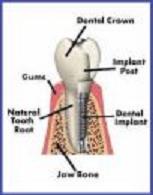 Dental implants are one of the most predictable ways to replace missing teeth. They are biocompatible anchors that are placed in the bone and acts as roots of your teeth. Implants are made from titanium steel, which is readily accepted by the body. After placement, a porcelain crown is attached to the top of the implant. When done properly, dental implants look, feel and function like natural teeth.
Dental implants are one of the most predictable ways to replace missing teeth. They are biocompatible anchors that are placed in the bone and acts as roots of your teeth. Implants are made from titanium steel, which is readily accepted by the body. After placement, a porcelain crown is attached to the top of the implant. When done properly, dental implants look, feel and function like natural teeth.
Accepted by the American Dental Association, dental implants have been used successfully for many years. How does it work? It is a process called osseointegration, meaning that titanium is so compatible that bone actually attaches itself to the implant. The advantages include reduction of long-term bone resorption in the jaw, the ability to restore a missing tooth without altering adjacent teeth, and long term success with high esthetic results.
Who needs Dental Implants?
Anyone who is missing teeth can benefit from having implants. Implants allow you to restore proper function to your bite and will give you a beautiful esthetic smile. Implants can be the solution for patients who find it difficult or impossible to wear a removable partial or complete denture.
Eligible candidates require the following:
- Have enough jaw bone to secure the implants
- Do not have a disease or condition that interferes with proper healing of bone (i.e. uncontrolled diabetes, radiation/chemotherapy, etc.)
How do I start?
First, a thorough examination and medical history review is conducted with us. Your exam may include more than one type of x-rays to provide the essential information for this process. Once we determine that you are a candidate, we will refer you to a trusted implant surgeon and will work together with him/her from beginning to completion.
What to expect and how long?
Stage I Surgery: This first procedure involves placing the implant into bone under local or general anesthesia (this will be determined by you and the implant surgeon). The integration to bone will take place as soon as healing begins. The implant should be firmly anchored to bone within four to six months. Some cases may require bone grafting to assure that the implant can completely be secured in bone.
Stage II Surgery: After healing is completed, the second stage surgery is done under local anesthesia. The implant residing under the gums is exposed for access by the surgeon, so that we, the restorative dentists, can place a crown restoration.
Stage III: When your gum tissues have completely healed after Stage II surgery(usually 2-3 weeks), you are ready for the placement of a permanent crown(s) in our office.
